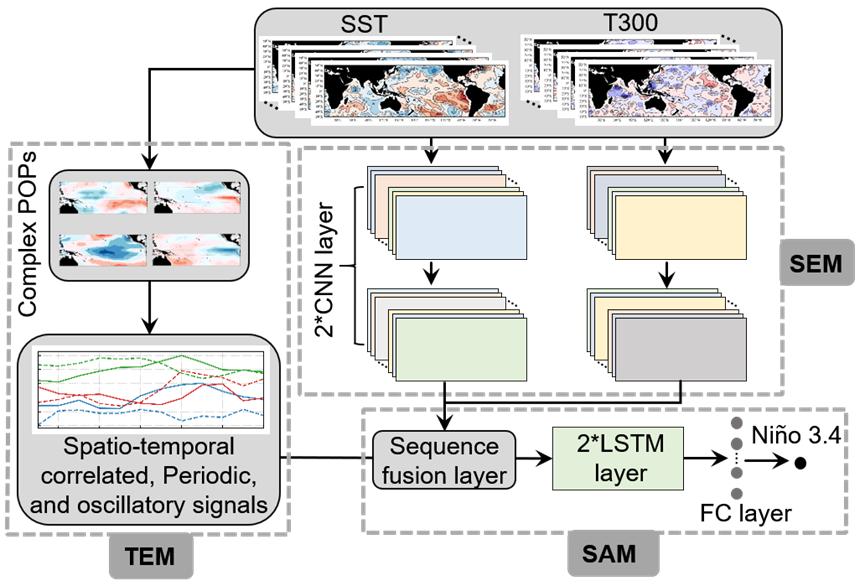
El Niño-Southern Oscillation (ENSO), the strongest interannual climate phenomenon originating from ocean-atmosphere interactions in the equatorial Pacific, influences global climate system. Accurate and timely prediction of ENSO is necessary for reliable weather and climate forecasts.
Artificial neural network (ANN) has emerged as a powerful approach for improving ENSO-related climate prediction and projection.
Recently, Ph. D. student ZHOU Lu of Prof. ZHANG Ronghua's team from the Institute of Oceanology of the Chinese Academy of Sciences (IOCAS) developed a novel hybrid model, named as POP-Net, by combining principal oscillation pattern (POP) analyses with convolutional neural network (CNN)-long short-term memory (LSTM) algorithm to improve Niño-3.4 sea surface temperature (SST) index prediction.
The study was published in Advances in Atmospheric Sciences on Mar. 8.
The POP analysis method used in POP-Net is a technique to extract periodically propagating patterns composed of real and imaginary parts of the POP modes from a multi-component system. Based on the spatio-temporal correlated properties of ENSO-related anomaly fields, POP analyses were first used to extract quasi-periodically propagating patterns from the complex climate system.
Furthermore, the specific POP patterns can be selected to formulate a POP-based prediction model or incorporated into a data-driven model configuration, such as CNN-LSTM, to formulate hybrid model, named as POP-Net. "The hybrid model constructed by this method can reduce the difficulty for ANNs to search for predictable information in an automatic way and thus achieves higher prediction accuracy for ENSO," said ZHOU.
The POP-based pre-processing can enhance ENSO-related signals of interest while filtering out unrelated noise. By comparing with POP-based model and CNN-LSTM individually, POP-Net indeed exhibited the ability to improve ENSO prediction skills, with correlation coefficients exceeding 0.5 up to a lead time of 17 months during the 1994-2020 validation period. Moreover, the POP-Net also alleviated the spring predictability barrier.
"The superiority of the POP-Net over the other two individually configured models in terms of ENSO predictions indicates that value-added artificial neural networks for improved ENSO predictions are feasible by including the process-oriented analyses to enhance signal representations," said Prof. ZHANG.
This research was supported by the Strategic Priority Research Program of the Chinese Academy of Sciences and the National Natural Science Foundation of China.

Architecture of the POP-Net model configured for the Niño-3.4 index prediction (Image by IOCAS)

86-10-68597521 (day)
86-10-68597289 (night)

52 Sanlihe Rd., Xicheng District,
Beijing, China (100864)

